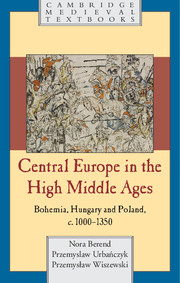Book contents
- Frontmatter
- Contents
- Note and acknowledgements
- Maps
- 1 Introduction: did Central Europe exist in the Middle Ages?
- 2 The history of the region and the question of origins
- 3 The formation of polities and Christianization
- 4 Political life and government, c. 1050–c. 1200
- 5 Society and the economy, eleventh–twelfth centuries
- 6 Ecclesiastical history, eleventh–thirteenth centuries
- 7 New developments of the thirteenth century
- Select bibliography
- Index
- References
5 - Society and the economy, eleventh–twelfth centuries
Published online by Cambridge University Press: 05 June 2014
- Frontmatter
- Contents
- Note and acknowledgements
- Maps
- 1 Introduction: did Central Europe exist in the Middle Ages?
- 2 The history of the region and the question of origins
- 3 The formation of polities and Christianization
- 4 Political life and government, c. 1050–c. 1200
- 5 Society and the economy, eleventh–twelfth centuries
- 6 Ecclesiastical history, eleventh–thirteenth centuries
- 7 New developments of the thirteenth century
- Select bibliography
- Index
- References
Summary
The economy of Bohemia, Hungary and Poland remained mainly agricultural in the period, although towns started to play a role everywhere in the twelfth century. Society in all the polities became more complex and hierarchical over the period.
POPULATION SIZE
The size of the population can only be guessed at hypothetically: rare contemporary population numbers for certain groups (which are not statistics in the modern sense), archaeological or other indicators for sizes of villages and churches, analogies with western Europe (where the calculation of medieval populations cannot be precise either) and the use of theoretical frameworks for the size of families or likely population growth combine to provide very provisional and debatable estimates.
It is extremely difficult to estimate the population of the Piast realm in the eleventh and twelfth centuries in absolute numbers. Using regression analysis applied to later data on the collection of Peter’s pence, it has been estimated that around the year 1000 Poland’s population was about 1.25 million, but this figure is rough and appears too high. Estimates of population density in particular areas based on archaeological data seem more trustworthy, and can be added up for the entire country. Keeping in mind their hypothetical character and modifications introduced to make them consistent with historical studies, scholars have pointed to the systematic growth of population density during the period in question.
- Type
- Chapter
- Information
- Central Europe in the High Middle AgesBohemia, Hungary and Poland, c.900–c.1300, pp. 250 - 314Publisher: Cambridge University PressPrint publication year: 2013

